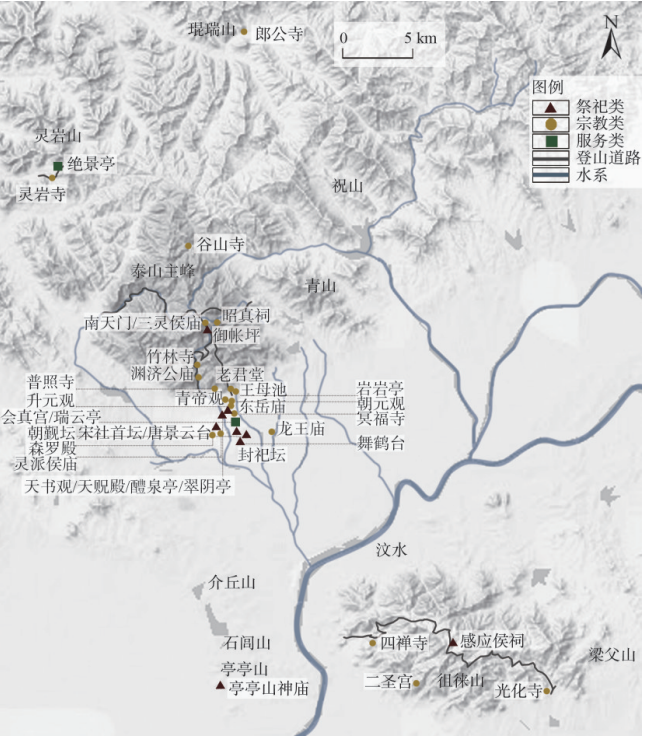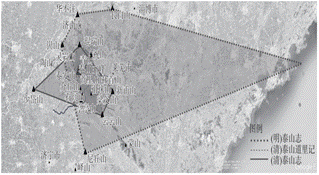A study of Mount Tai though Foucault’s power theory
Foreword
China has had unique natural resources since ancient times, such as famous mountains like Huashan and Mount Heng. People have always regarded Mount Tai as a very sacred and solemn place. From the Qin Dynasty to the Song Dynasty, different emperors have visited Mount Tai to share their merits with the people and the Gods. However, the sense of place for the people has a big difference between the past and now. Hence, tthis proposal focuses on the reasons for the changes in the functions of Mount Tai and tries to analyze it from the perspective of cultural geography.
1. Introduction
As mentioned before, China has had unique natural resources since ancient times. In fact, Mount Tai is not the highest and biggest mountain in China. However, it is still regarded as the foremost of the “Five Great Mountains”. Since Mount Tai is located in the middle and lower reaches of the Yellow River. The people here have entered the stage of civilization the fastest. (張元衡,1995) At the same time, there are also the Yellow River, Jishui, Huaihe and Yangtze River here. Therefore, the unique natural conditions and the cognition of the people at that time gave the uniqueness of Mount Tai. Chinese people who believe in pantheism hence, believe Mount Tai is the place for them to communicate with God, who holds their destiny. In order to communicate with Gods to get a good life, people started to hold different activities in the mountain. Before the place for political uses, people dedicated animals to different corners of the mountain. In addition, during the Zhou Dynasty, the emperor had been hunting animals here. (Zhang, Zhang, 2019) Therefore, before the political space, Mount Tai was still in a primitive state since no building existed at that time, but the people had already produced invisible traces.
2. A Cultural Geographical Perspective on Mount Tai
Since Mount Tai had been gone throught different ages, even have different buildings already developed in the beginning like Dai Tample. Hence, this paper try to applied Agnew and Duncan’s theory of three constituent parts of place to find out the use of change in Mount Tai, especially focus of the sense of the place of people. Secondly, the change of Mount Tai also involved the power of different group, for instance, political and religion, etc. Therefore, this paper will focues on the transformative capacity of different group.
3. Empirical Analysis
3.1The political use of Mount Tai
The unique natural conditions and the cognition of the people provided a way for them to pray for a better life. They started to believe that Mount Tai was a very sacred and solemn place. This attracted the attention of the emperors, hoping to show their merits to Gods to show their legitimacy as a leader. The different buildings were therefore created by the emperors.
For instance, Feng Chan Ceremony is to build altars at the top and the bottom of Mount Tai by a contemporary monarch. Round altars and square altars are used for the top and bottom, respectively. The scales of the ceremony and the level of altars depend on political achievements. It is also used as a way to display political achievements and emphasize the orthodoxy of the dynasty.
The requirements of the ceremony are strict. The people must live and work in peace. Besides, it should be politically stable. It implies that the emperor is appointed by the Gods. The emperor is orthodox and accepted by citizens.
Those altars act as traces for the people living in that dynasty. It implies that people accept the emperor, or else the ceremony cannot be held successfully. Several cities were built for the ceremony. The locations of cities show the traditional way of living of people, which are under the mountain and above the water.
3.2 The function change of Mount Tai
There are several times massive functional changes of Mount Tai, for instance from political use to religious use then change to travel use,which made Mount Tai liberation to public areas.
In the Song Dynasty, folk who lived near Mount tai developed a new religion. Many folks trust Bixia Yuanjun ,Bixia Yuanjun is a religion developed from the mount tai but replacing mount tai takes the place in people's mind. They believed in the Bixia Yuanjun domination of the born in the world.It caused more folk to build many religious temples in mount tai(Figure1), temples change the trace and function of mount tai. Mount Tai no longer serve for the political but also serve folk because Mount Tai area starts to be shared by religion reason, reflect that folk try to establish some new meaning for mount tai.Mount Tai also provide some new function to people.

Fig.1 The functional changes of of greater Mount Tai demonstrate on the building (Zhang, Zhang, 2019)
Beside that, another main reason for Mount Tai being liberated is that since the Ming dynasty, emperor Zhu Yuanzhang dismissed the sacred place of Mount Tai. In this situation the emperor used his capacity to decrease the political function of mount tai. In this period mount tai was changing from politics to a place for public use.After that the trace of political use is almost disappearing,but the importance of religion is increasing. This situation has continued for hundreds of years.
In recent decades there has been another massive change of its function. Mount Tai is no longer a religious or political place but has changed to a dual cultural heritage. Economics and culture is the vital role to give impetus to change the trace of mount tai. However, economics and culture also scramble the space of mount tai. Both of the stakeholders would like to change the trace of mount tai to get more benefit.
To sum up the trace and sense of place keeps changing, behind that is many different stakeholders have different ideas to shape the trace of mount tai the reason is they want to establish the sense of Mount Tai.
3.3 The integrated use of Mount Tai
There are diverse uses of Mount Tai in both humanities and natural aspects nowadays. As mentioned in the last paragraph, the political use of Mount Tai is fading after the Ming and Qing Dynasty, the Feng Chan Ceremony no longer exists and influence on the public. Also, there is not sole usage in a particular aspect like in the ancient period, but the diversity of usage in at least 3 aspects: tourism, environment protection and scientific research.
3.4 Tourism
Mount Tai is known as the most potential destination in China, Top 10 of the best destinations in cultural tourism, Top 10 of the beautiful mountains in China, famous scenery for photography and self-driving tours and the city with the most cultural atmosphere in 2014. As we can see from the fame above, there is no doubt that Mount Tai is a famous tourist hotspot in both domestic tourism and outbound tourism. In fact, there are crowds of people visiting Mount Tai especially in the peak tourism period, like there are 386 thousand tourists visiting Mount Tai during the 7 days of the National Week period in 2019 before the epidemic of Covid-19(齊魯網,2019). Even under the situation of Covid-19 epidemic and epidemic prevention and control policy, there are still around 12 million tourists visiting Tai An during the first quarter of 2021, which is 88% when compared to the same period of 2019 before the outbreak of Covid-19(泰安市文化和旅游局,2021). Such statistics show that the tourism demand of Mount Tai is strong even under the epidemic period. Not only for the number of tourists, the praise also shows that Mount Tai attracts different types of tourism purposes, such as sightseeing and Cultural Tourism.
Therefore, Mount Tai is a comprehensive tourist area which attracts many tourists for different types of tourism purposes. When compared to other cultural or natural heritage, Mount Tai as a Mixed heritage seems to be more attractive to the tourist.
3.5 Environment protection
Mount Tai is a mixed heritage site containing elements of both natural and cultural significance according to the definition of UNESCO. Mount Tai is covered by different types of protected area, many of them overlap in the same region. As shown in the picture below, the main peak of Mount Tai is covered by at least three types of different protected areas in Provincial, national, and international level. Like the Provincial Nature Reserve, National Park and UNESCO Global Geopark. Different protected areas contain different laws to protect the different aspects of Mount Tai. The boundary of the protected area defined by the conservation value in each region. So, the distribution of the protected area is scattered,but not the whole area of Mount Tai.

Fig.2 The Spatial scale change of greater Mount Tai (Zhang, Zhang, 2019)

Fig.3 Protected areas within Mount Tai (Zhang, Zhang, 2019)
The compartmentalization of the Mount Tai area is quite different when compared to the past. As shown in the picture above, the area of Mount Tai in the past is a whole region, but not combined by many scattered areas under the compartmentalization of the protected area. People see Mount Tai as a sacred area, but the definition of protected area is judged by the value.
Apart from tourism and protection, Mount Tai is also an important area for scientific research in ecosystem and geology there. As we can list at least three functions of Mount Tai, it shows the diversity of usage of the Mount Tai area. And the functions are no longer just for the ruling class, but the general public.
4.Conclusion
To conclude, Mount Tai has different space uses for the people, including the original state, political, and religious space, before entering the current public use. It is clear to know that different parties who own the transformative capacity change the use of the space, for instance, the king builds different traces in the empty Mount Tai. Moreover, the senses of the place of the people in different periods are also change.
References
1.王恩田.(2002).東嶽泰山考辯.濟南教育學院學報,(3).頁1-7
2.周郢.(2013).從廟堂到民間:明清時期泰山文化之轉變.民俗研究,(6).http://106.37.81.211:8082/images/sjsimages/pdf/qk/xadzkjdxxb-shkxb/xadz2012/1205pdf/120516.pdf
3.張用衡 .(1995). 《泰山》,北京:知識岀版社。
4.張婧雅, & 張玉鈞. (2019). 自然保護地的文化景觀價值演變與識別——以泰山為 例. 自然資源學報, 34(9), 1833–1849. https://doi.org/10.31497/zrzyxb.20190904
5.泰安市文化和旅遊局2021年全市一季度經濟運行分析.(2021).
6.齊魯網.(2019).<国庆期间38.6万游客游览泰山 生态旅游成泰安旅游重要名片>,http://yunhe.china.com.cn/2019-10/10/content_40916355.htm


